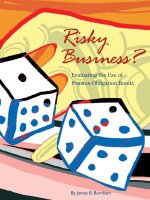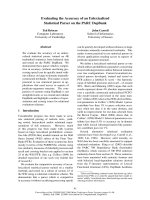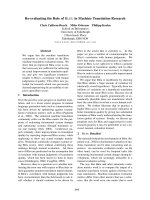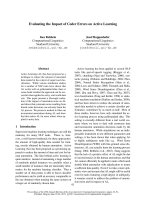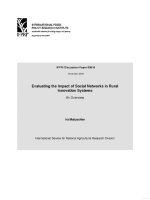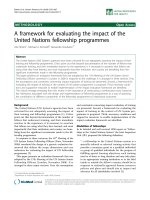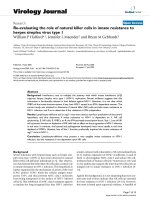Evaluating the trends of population data, effective population size and inbreeding rate as conservation indices of old Hungarian poultry breeds between 2000 and 2015
Bạn đang xem bản rút gọn của tài liệu. Xem và tải ngay bản đầy đủ của tài liệu tại đây (442.26 KB, 14 trang )
Europ.Poult.Sci., 80. 2016, ISSN 1612-9199, © Verlag Eugen Ulmer, Stuttgart. DOI: 10.1399/eps.2016.132
Europ.Poult.Sci., 80. 2016, ISSN 1612-9199, © Verlag Eugen Ulmer, Stuttgart. DOI: 10.1399/eps.2016.132
Evaluating the trends of population data, effective population size and
inbreeding rate as conservation indices of old Hungarian poultry breeds
between 2000 and 2015
Auswertung der Trends in den Populationskennwerten, der effektiven Populationsgrưße und
der Inzuchtkoeffizienten als Indikatoren für den Erhalt alter ungarischer Geflügelrassen
zwischen den Jahren 2000 und 2015
1,2
1,2*
1,2
1,2
1,2
1,2
2,3
2,4
I.T. Szalay , T.N. Lan Phuong , I. Barta , J.N. Kovacs , K.D.T. Dong Xuan , L. Bodi , S. Mihok , A. Benk
and K. Kovacsne Gaal
2,5
1
Research Centre for Farm Animal Gene Conservation (HaGK), Godollo, Hungary
2
Association of Hungarian Small Animal Breeders for Gene Conservation (MGE), Godollo, Hungary
3
University of Debrecen, Faculty of the Agricultural and Food Sciences and Environmental Management (DE-MEK), Debrecen, Hungary
4
5
University of Szeged, Faculty of Agriculture (SZTE-MGK), Hodmezovasarhely, Hungary
University of West-Hungary, Faculty of Agricultural and Food Sciences (NYME-MEK), Mosonmagyarovar, Hungary
*Correspondence:
Manuscript received 10 November 2015, accepted 8 March 2016
Introduction
Over past decades, many surveys have been conducted to evaluate the breeding population size of native breeds
throughout the world (HOFFMANN, 2005). From those studies, it has been shown, that many of the existing poultry
genetic resources are in critical or endangered status in Europe (SCHERF, 2000; WOELDERS et al., 2006). Although
traditional, unselected poultry breeds are widely heterogeneous populations (HILLEL et al., 1999; TIXIER-BOICHARD et
al., 1999), there has been a significant decrease in the number of individuals (GANDINI and VILLA, 2003), as well as a
noticeable disappearance of breeds (GEERLINGS et al., 2002).
Conservation activities focus on genetic management, maximise the effective number of individuals in the gene
pool, raise the awareness of practices that may increase inbreeding coefficients and helps in preventing erosion of
animal genetic diversity (SZALAY et al., 2009). The rate of inbreeding was defined as the change of inbreeding per
generation relative to the amount of inbreeding that can still occur (FAO, 2013). It is well known that a high rate of
inbreeding in a population leads to a reduction of genetic variability (ROBERTSON, 1952; LYNCH and HILL, 1986;
KEIGHTLEY and HILL, 1987; WEI et al., 1996; KRISTENSEN and SORENSEN, 2005) and results in inbreeding depression
(defined by DARWIN in 1868), as well as deleterious effects on offspring fitness (PIRCHNER, 1985). Poultry studies have
shown that a high inbreeding rate affects fertility, hatchability, embryonic mortality and egg production (BLOW and
GLAZENER, 1953; CAHANER et al., 1980, SEWALEM et al., 1999; RAHMANIAN et al., 2015). Numerous authors have
discussed effective population size and the inbreeding rate of local avian species (SPALONA et al., 2007; LARIVIERE et
al., 2011), but recently, no work deliberating on the number of registered breeding stocks of poultry genetic
resources could be found. This study aims to analyse the effective population size (Ne), inbreeding rate (ΔF) and the
number of registered breeding stocks (n), within the populations of 14 local Hungarian poultry breeds. It would be
the first attempt to publish the trends of population data of old Hungarian breeds from the year 2000 up to now, to
provide additional information on the effectiveness of the Hungarian poultry conservation strategy.
17.05.2016
1 / 14
Europ.Poult.Sci., 80. 2016, ISSN 1612-9199, © Verlag Eugen Ulmer, Stuttgart. DOI: 10.1399/eps.2016.132
Materials and methods
Until the beginning of commercial poultry breeding in Hungary, the landrace varieties of old breeds were kept in
countryside regions. In order to keep up with other European and oversea chicken breeds, a major breeding program
was started at the predecessor of the Research Centre for Farm Animal Gene Conservation (HaGK) in Godollo in the
early 1930 s. During the Second World War, however, the majority of breeding stocks were destroyed. Nevertheless,
thanks to systematic breeding work of Balint Baldy and colleagues, Hungarian poultry breeds were not only
preserved, but also propagated again in great quantities by the 1950 s (BISZKUP and BEKE, 1951; BALDY, 1954).
Beginning in the early 1960 s, parallel with the expansion of commercial poultry breeding, Hungarian breeds were
replaced by foreign hybrids even in small-scale farms. In the early 1970 s, the conservation of local chicken breeds
became the task of the Hungarian Animal Breeding Authority to maintain Hungarian and Transylvanian breeds as
gene reserves. In 1990 s, non-governmental organisations took over the breed protection programmes in farm
animal gene conservation according to new regulations in animal breeding.
Realising that live collections cannot be replaced or ensured by cryopreservation only (DELANY, 2003), and that in
situ, in vivo poultry gene banks are essential, based on the existing breeding stocks of the Institute for Small Animal
Research (predecessor of HaGK) and 3 agricultural universities in Mosonmagyarovar, Debrecen and
Hodmezovasarhely, new poultry conservation programmes were started in the early 1990 s. The historical overviews
of those activities were published by KOVACSNE GAAL (2004), MIHOK (2004), SOFALVY (2005) and SZALAY (2002;
2015). The recent Hungarian conservation strategy of poultry genetic resources adheres to the general direction of
European Union (EU) conservation programmes. Conserved stocks have been maintained for several decades, while
some of them are the result of recent gene rescue programmes (SZALAY, 2015). The Association of Hungarian Small
Animal Breeders for Gene Conservation (MGE) was appointed as the official breeding organisation for old poultry
breeds by the breeding authorities in 1998, with the tasks of elaborating and supervising the breeding programmes,
as well as registering the existing stocks for conservation. In 2008, succeeding a departmental order of the
Hungarian Ministry of Agriculture (FVM, 2007), an official registration of all poultry breeding stocks, including
those kept under conservation programmes are under the control of the breeding authority within the Hungarian
Poultry Information System. In 2010, a special EU subsidy system was elaborated and started for all officially
registered Hungarian farm animal genetic resources, including poultry. Since then, the participation of both
institutional and individual breeders has been encouraged to take part in the conservation programme for either
research or production purposes, which resulted in the expansion of the population size and number of breeding
stocks of the pure breeds. Those stocks originated from either the already existing breeding stocks or gene rescue
programmes.
After approximately 40 years of execution of the conservation programme, the total number of old Hungarian
poultry breeds has been increased up to 14, mainly due to the registration of colour varieties as separate breeds,
presently including Yellow Hungarian chicken (YHc), White Hungarian chicken (WHc), Speckled Hungarian chicken
(SHc), Partridge Coloured Hungarian chicken (PHc), White Transylvanian Naked Neck chicken (WTc), Black
Transylvanian Naked Neck chicken (BTc), Speckled Transylvanian Naked Neck chicken (STc), Hungarian Landrace
Guinea Fowl (HLgf), Frizzled Hungarian Goose (FHg), Hungarian Goose (HUg), White Hungarian Duck (WHd), Wild
Coloured Hungarian Duck (WId), Copper Turkey (COt) and Bronze Turkey (BRt) as shown in Table 1. New
conservation stocks were established by the use of pedigreed offspring of original, institutional and closed
populations mentioned above.
17.05.2016
2 / 14
Europ.Poult.Sci., 80. 2016, ISSN 1612-9199, © Verlag Eugen Ulmer, Stuttgart. DOI: 10.1399/eps.2016.132
Table 1. List of Hungarian poultry breeds and the locations of breeders registered in the conservation programme
Liste der untersuchten ungarischen Geflügelrassen und die Lage der im Erhaltungszuchtprogramm registrierten Züchter
Breeds
Labels
Locations of breeders
Yellow Hungarian chicken
YHc
White Hungarian chicken
WHc
Godollo, Mosonmagyarovar
Dejtar, Apajpuszta, Farmos, Napkor
Godollo, Dejtar, Apajpuszta, Napkor
Speckled Hungarian chicken
SHc
Partridge Coloured Hungarian chicken
White Transylvanian Naked Neck chicken
PHc
WTc
Black Transylvanian Naked Neck chicken
Speckled Transylvanian Naked Neck chicken
BTc
STc
Hungarian Landrace Guinea Fowl
HLgf
Frizzled Hungarian Goose
FHg
Hungarian Goose
White Hungarian Duck
Wild Coloured Hungarian Duck
Copper Turkey
HUg
WHd
WId
COt
Godollo, Dejtar, Apajpuszta, Napkor
Godollo, Dejtar, Apajpuszta
Napkor
Godollo, Apajpuszta, Napkor
Hortobagy, Tiszafured, Budapest
Godollo, Apajpuszta, Farmos, Napkor,
Tiszafured, Budapest
Godollo, Farmos
Godollo, Apajpuszta, Farmos, Budapest
Godollo, Apajpuszta, Farmos
Godollo, Apajpuszta, Napkor
Bronze Turkey
BRt
Godollo, Apajpuszta, Napkor
Godollo, Dejtar, Apajpuszta, Farmos,
Napkor, Budapest
Godollo, Apajpuszta, Napkor, Budapest
Godollo, Dejtar, Apajpuszta, Napkor
Only the population data of entirely controlled stocks of the highest breeding level (either officially registered or
existing and temporarily unregistered) were considered for evaluation in this study. The data were collected
consistently from 2000 to 2015 by MGE and HaGK. Yearly, the n of each traditional Hungarian poultry breed, the
number of breeding males (Nm) and females (Nf) were monitored. Sex ratio (Nm/Nf) is defined as the Nm to the Nf in a
population. The Ne is the number of individuals from a population that are randomly selected and randomly mated
and would be expected to have the same rate of inbreeding (WAPLES, 2002). Since breeding birds were kept in various
locations of Hungary, the assumptions of random mating and no selection are unrealistic. In this study, however, Ne
was estimated to only provide the presumption of upper limit. ΔF within a population is inversely proportional to Ne.
The estimation of Ne and ΔF was based on the formula given by WRIGHT (1931) as follows:
Where: Nf is the number of breeding females, Nm is the number of breeding males.
The ratio of the effective population size to total population size (Ne/N) was also calculated to indicate the extent of
genetic variation (FRANKHAM, 2007). Descriptive statistics and Pearson correlations were operated by SPSS software
(IBM CORP, 2011).
17.05.2016
3 / 14
Europ.Poult.Sci., 80. 2016, ISSN 1612-9199, © Verlag Eugen Ulmer, Stuttgart. DOI: 10.1399/eps.2016.132
Results
Nm, Nf, estimated Nm/Nf, Ne, Ne/N and ΔF are given in Tables 2, 3, 4 and 5, while Ne and n are shown in Figure 1.
There was no PHc, HLgf, WHd, WId breeding stock registered before 2004 and no HUg before 2005. The n of breeds
other than HUg, in which n remained unchanged (n = 2), increased year by year, reaching the peak in 2012 (YHc and
SHc with n = 10; COt and BRt with n = 9; HLgf with n = 8, PHc, BTc, STc, FHg and WId with n = 7; WHd with n = 5) or
in 2013 (WTc with n = 8). From 2013, a slight decrease in the n of most breeds can be seen. Changes are partly due to
a new 5 years subsidy system financed by the European Union for in vivo gene conservation of the registered breeds
and stocks between 2010 and 2014. Based on Nm/Nf, studied breeds can be categorised into 2 distinct groups, namely
a chicken group (1) that has relatively low Nm/Nf and a second group including HLgf, FHg, HUg, WHd, WId, Cot, BRt
having relatively high Nm/Nf. Ne varies widely, from 92 (COt in 2000) to 2581 (HLgf in 2012). It is generally higher in
the period between 2011 and 2013 than at other times. However, the Ne of WTc, BTc, STc, WHd and COt always
stayed below 1000 individuals. Huge enhancement of Ne can be seen in PHc (from 242 in 2009 to 1640 in 2013), in
HLgf (from 633 in 2009 to 2581 in 2012) and in HUg (from 163 in 2010 to 1262 in 2012). It has been noted that the
higher n is the greater is also Ne (Figure 1). Ne/N of all breeds is higher than 0.400 and it is highest in HLgf (0.980 in
2008). In the case of ΔF, the lowest of 0.019% and highest of 0.794% were recorded in 2012 (HLgf) and 2009 (WHd),
respectively. YHc and SHc had a ΔF lower than 0.108% during the entire investigating period. Populations with Ne
smaller than 100 birds had a ΔF higher than 0.500% (COt in 2000, 2002 and 2004; WHd in 2009). In the last 2 years
of analysis, 2014 and 2015, only HUg and WHd had a ΔF higher than 0.200%. Noticeably, there was a gradual
decline in the ΔF of PHc, HLgf, COt and BRt. In the breeds studied, with the exception of HUg (n is constant), the n
correlate positively with Ne, but negatively with ΔF (Table 6).
17.05.2016
4 / 14
Europ.Poult.Sci., 80. 2016, ISSN 1612-9199, © Verlag Eugen Ulmer, Stuttgart. DOI: 10.1399/eps.2016.132
Table 2. Total number of breeding males (Nm) and breeding females (Nf), sex ratio (Nm/Nf), ratio of effective population size and total
population size (Ne/N) and inbreeding rate (ΔF%) in % of YHc (Yellow Hungarian chicken), WHc (White Hungarian chicken), SHc (Speckled
Hungarian chicken) and PHc (Partridge Coloured Hungarian chicken) from 2000 to 2015 (Source: HáGK and MGE breeding archives and the
Hungarian Poultry Information System, supervised by the National Food Chain Safety Office, the breeding authority of Hungary)
Gesamtanzahl der männlichen (Nm) und weiblichen (Nf) Zuchttiere, das Geschlechterverhältnis (Nm/Nf), das Verhältnis von effektiver zur
Gesamt-Populationsgrưße (Ne/N) und die Inzuchtsteigerung in Prozent (ΔF%) für die Rassen YHc (Gelbe Ungarische Hühner), WHc (Weiße
Ungarische Hühner), SHc (Gesperberte Ungarische Hühner) sowie PHc (Rebhuhnfarbige Ungarische Hühner) zwischen 2000 und 2015
(Quelle: HáGK- und MGE-Zuchtarchive sowie Ungarisches Geflügel-Informationssystem, geleitet durch das Nationale Büro für Sicherheit in
der Lebensmittelkette, die Zuchtorganisation von Ungarn)
2000 2001 2002 2003 2004 2005 2006 2007 2008 2009 2010
YHc
WHc
SHc
17.05.2016
2012
2013
2014
2015
Nm
208
300
206
312
255
187
176
182
308
382
243
484
403
529
541
394
Nf
1597
1610
1700
1979
1736
1669
1605
1507
2067
1787
1317
2123
2761
3362
3063
3059
Nm/Nf
0.130 0.186 0.121 0.158 0.147 0.112 0.110 0.121 0.149 0.214 0.185 0.228
0.146
0.157
0.177
0.129
Ne/N
0.408 0.530 0.386 0.471 0.447 0.362 0.356 0.385 0.451 0.580 0.526 0.605
0.445
0.470
0.510
0.404
ΔF%
0.068 0.049 0.068 0.046 0.056 0.074 0.079 0.077 0.047 0.040 0.061 0.032
0.036
0.027
0.027
0.036
Nm
91
140
79
85
67
57
48
56
58
73
89
151
122
215
124
112
Nf
509
330
402
415
395
399
342
232
288
318
389
733
839
1292
807
696
Nm/Nf
0.179 0.424 0.197 0.205 0.170 0.143 0.140 0.241 0.201 0.230 0.229 0.206
0.145
0.166
0.154
0.161
Ne/N
0.515 0.837 0.549 0.564 0.496 0.438 0.432 0.627 0.558 0.607 0.606 0.567
0.443
0.489
0.462
0.478
ΔF%
0.162 0.127 0.189 0.177 0.218 0.251 0.297 0.277 0.259 0.211 0.173 0.100
0.117
0.068
0.116
0.130
273
381
298
269
Nm
Nf
PHc
2011
247
240
294
277
255
243
200
159
193
135
229
287
1692
1302
1577
1568
1440
1431
830
714
876
814
1007
1563
1883
2199
2016
1792
Nm/Nf
0.146 0.184 0.186 0.177 0.177 0.170 0.241 0.223 0.220 0.166 0.227 0.184
0.145
0.173
0.148
0.150
Ne/N
0.445 0.526 0.530 0.510 0.511 0.496 0.626 0.596 0.592 0.488 0.604 0.524
0.442
0.503
0.449
0.454
ΔF%
0.058 0.062 0.050 0.053 0.058 0.060 0.078 0.096 0.079 0.108 0.067 0.052
0.052
0.038
0.048
0.053
Nm
60
59
100
96
73
90
193
344
478
392
413
Nf
322
236
337
328
350
316
864
2371
2886
2662
2521
0.145
0.166
0.147
0.164
Nm/Nf
0.186 0.250 0.297 0.293 0.209 0.285 0.223
Ne/N
0.530 0.640 0.706 0.701 0.571 0.690 0.597
0.443
0.488
0.448
0.484
ΔF%
0.247 0.265 0.162 0.168 0.207 0.178 0.079
0.042
0.030
0.037
0.035
5 / 14
Europ.Poult.Sci., 80. 2016, ISSN 1612-9199, © Verlag Eugen Ulmer, Stuttgart. DOI: 10.1399/eps.2016.132
Table 3. Total number of breeding males (Nm) and breeding females (Nf), sex ratio (Nm/Nf), ratio of effective population size and total
population size (Ne/N) and inbreeding rate (ΔF%) in per cent of WTc (White Transylvanian Naked Neck chicken), BTc (Black Transylvanian
Naked Neck chicken) and STc (Speckled Transylvanian Naked Neck chicken) from 2000 to 2015 (Source: HáGK and MGE breeding archives
and the Hungarian Poultry Information System, supervised by the National Food Chain Safety Office, the breeding authority of Hungary)
Gesamtanzahl der männlichen (Nm) und weiblichen (Nf) Zuchttiere, das Geschlechterverhältnis (Nm/Nf), das Verhältnis von effektiver zur
Gesamt-Populationsgrưße (Ne/N) und die Inzuchtsteigerung in Prozent (ΔF%) für die Rassen WTc (Weiße Transsilvanische Nackthälse), BTc
(Schwarze Transsilvanische Nackthälse) und STc (Gesperberte Transsilvanische Nackthälse) zwischen 2000 und 2015 (Quelle: HáGK- und
MGE-Zuchtarchive sowie Ungarisches Geflügel-Informationssystem, geleitet durch das Nationale Büro für Sicherheit in der
Lebensmittelkette, die Zuchtorganisation von Ungarn)
2000 2001 2002 2003 2004 2005 2006 2007 2008 2009 2010
WTc
BTc
STc
2012
2013
2014
2015
Nm
81
140
78
87
75
59
51
55
58
72
93
150
113
267
165
113
Nf
519
329
418
399
340
373
302
221
243
255
312
624
892
1643
1087
699
Nm/Nf
0.156 0.426 0.187 0.218 0.221 0.158 0.169 0.249 0.239 0.282 0.298 0.240
0.127
0.163
0.152
0.162
Ne/N
0.467 0.838 0.530 0.588 0.592 0.472 0.494 0.638 0.622 0.687 0.708 0.625
0.399
0.481
0.458
0.479
ΔF%
0.178 0.127 0.190 0.175 0.203 0.245 0.286 0.284 0.267 0.223 0.174 0.103
0.125
0.054
0.087
0.129
Nm
76
140
78
98
77
64
51
56
58
76
90
159
113
243
164
112
Nf
484
330
418
419
288
289
190
208
289
275
379
654
870
1556
1084
698
Nm/Nf
0.157 0.424 0.187 0.234 0.267 0.221 0.268 0.269 0.201 0.276 0.237 0.243
0.130
0.156
0.151
0.160
Ne/N
0.469 0.837 0.530 0.614 0.666 0.594 0.667 0.669 0.557 0.679 0.620 0.629
0.407
0.467
0.457
0.477
ΔF%
0.190 0.127 0.190 0.157 0.206 0.239 0.311 0.283 0.259 0.210 0.172 0.098
0.125
0.059
0.088
0.130
161
229
169
156
Nm
Nf
17.05.2016
2011
94
168
119
121
112
107
93
79
90
97
130
199
506
582
562
613
610
697
510
350
361
361
521
896
934
1222
1023
894
Nm/Nf
0.186 0.289 0.212 0.197 0.184 0.154 0.182 0.226 0.249 0.269 0.250 0.222
0.172
0.187
0.165
0.174
Ne/N
0.528 0.695 0.577 0.551 0.524 0.461 0.522 0.601 0.639 0.668 0.639 0.595
0.502
0.532
0.487
0.506
ΔF%
0.158 0.096 0.127 0.124 0.132 0.135 0.159 0.194 0.174 0.163 0.120 0.077
0.091
0.065
0.086
0.094
6 / 14
Europ.Poult.Sci., 80. 2016, ISSN 1612-9199, © Verlag Eugen Ulmer, Stuttgart. DOI: 10.1399/eps.2016.132
Table 4. Total number of breeding males (Nm) and breeding females (Nf), sex ratio (Nm/Nf), ratio of effective population size and total
population size (Ne/N) and inbreeding rate (ΔF%) in per cent of HLgf (Hungarian Landrace Guinea Fowl), COt (Copper Turkey) and BRt
(Bronze Turkey) from 2000 to 2015 (Source: HáGK and MGE breeding archives and the Hungarian Poultry Information System, supervised by
the National Food Chain Safety Office, the breeding authority of Hungary)
Gesamtanzahl der männlichen (Nm) und weiblichen (Nf) Zuchttiere, das Geschlechterverhältnis (Nm/Nf), das Verhältnis von effektiver zur
Gesamt-Populationsgrưße (Ne/N) und die Inzuchtsteigerung in Prozent (ΔF%) für die Rassen HLgf (Ungarisches Landperlhuhn), COt
(Kupferpute) und BRt (Bronzepute) zwischen 2000 und 2015 (Quelle: HáGK- und MGE-Zuchtarchive sowie Ungarisches GeflügelInformationssystem, geleitet durch das Nationale Büro für Sicherheit in der Lebensmittelkette, die Zuchtorganisation von Ungarn)
2000 2001 2002 2003 2004 2005 2006 2007 2008 2009
HLgf
Nm
Nf
COt
BRt
17.05.2016
93
85
112
330
262
227
215
401
445
400
2010
2011
2012
2013
2014
2015
332
590
855
617
440
340
1099
1701
2631
1798
1510
1508
Nm/Nf
0.410 0.395 0.279 0.742 0.655
0.302
0.347
0.325
0.343
0.291
0.225
Ne/N
0.825 0.812 0.683 0.978 0.957
0.713
0.765
0.740
0.761
0.699
0.601
ΔF%
0.189 0.205 0.143 0.066 0.079 0.049
0.029
0.019
0.027
0.037
0.045
Nm
30
44
34
49
31
45
47
77
72
48
105
168
281
290
231
196
Nf
100
167
92
120
120
167
148
268
220
220
330
527
868
1125
940
770
Nm/Nf 0.300 0.263 0.370 0.408 0.258 0.269 0.318 0.287 0.327 0.218
0.318
0.319
0.324
0.258
0.246
0.255
Ne/N
0.710 0.660 0.788 0.824 0.653 0.669 0.732 0.694 0.743 0.588
0.732
0.733
0.739
0.652
0.633
0.647
ΔF%
0.542 0.359 0.504 0.359 0.507 0.353 0.350 0.209 0.230 0.317
0.157
0.098
0.059
0.054
0.067
0.080
Nm
112
80
102
106
85
78
97
90
83
50
123
194
315
317
251
205
Nf
440
240
282
329
350
340
286
298
212
210
379
672
972
1208
977
828
Nm/Nf 0.255 0.333 0.362 0.322 0.243 0.229 0.339 0.302 0.392 0.238
0.325
0.289
0.324
0.262
0.257
0.248
Ne/N
0.647 0.750 0.780 0.737 0.629 0.607 0.756 0.713 0.809 0.621
0.740
0.695
0.739
0.659
0.650
0.636
ΔF%
0.140 0.208 0.167 0.156 0.183 0.197 0.173
0.135
0.083
0.053
0.050
0.063
0.076
0.181 0.210 0.310
7 / 14
Europ.Poult.Sci., 80. 2016, ISSN 1612-9199, © Verlag Eugen Ulmer, Stuttgart. DOI: 10.1399/eps.2016.132
Table 5. Total number of breeding males (Nm) and breeding females (Nf), sex ratio (Nm/Nf), ratio of effective population size and total
population size (Ne/N) and inbreeding rate (ΔF%) in per cent of FHg (Frizzled Hungarian Goose), HUg (Hungarian Goose), WHd (White
Hungarian Duck) and WId (Wild Coloured Hungarian Duck) from 2000 to 2015 (Source: HáGK and MGE breeding archives and the Hungarian
Poultry Information System, supervised by the National Food Chain Safety Office, the breeding authority of Hungary)
Gesamtanzahl der männlichen (Nm) und weiblichen (Nf) Zuchttiere, das Geschlechterverhältnis (Nm/Nf), das Verhältnis von effektiver zur
Gesamt-Populationsgrưße (Ne/N) und die Inzuchtsteigerung in Prozent (ΔF%) für die Rassen FHg (Ungarische Seidengans), HUg
(Ungarische Gans), WHd (Weiße Ungarische Ente) und WId (farbige Ungarische Wildente) zwischen 2000 und 2015 (Quelle: HáGK- und
MGE-Zuchtarchive sowie Ungarisches Geflügel-Informationssystem, geleitet durch das Nationale Büro für Sicherheit in der
Lebensmittelkette, die Zuchtorganisation von Ungarn)
2000
FHg
HUg
WHd
17.05.2016
2002
2003
2004
2005
2006
2007
2008
2009
2010
2011
2012
2013
2014
2015
Nm
114
146
146
187
165
139
166
96
89
98
145
450
389
396
310
375
Nf
400
483
382
436
650
518
487
222
214
237
424
1268
1473
1437
1110
1327
Nm/Nf
0.285
0.302
0.382
0.429
0.254
0.268
0.341
0.432
0.416
0.414
0.342
0.355
0.264
0.276 0.279 0.283
Ne/N
0.690
0.713
0.800 0.840 0.646 0.667
0.758
0.843 0.830 0.828 0.760
0.773
0.661
0.677 0.683 0.687
ΔF%
0.141
0.111
0.118
0.101
0.187
0.038
0.041 0.040 0.052 0.043
0.096 0.095
0.114
0.199
0.180
0.116
Nm
121
81
60
60
63
193
201
423
70
85
Nf
246
180
174
134
115
565
612
1240
251
220
Nm/Nf
0.492 0.450
0.345
0.448 0.548
0.342
0.328
0.341 0.279 0.386
Ne/N
0.884 0.856
0.763
0.855
0.915
0.759
0.744
0.759 0.682 0.804
ΔF%
0.154
0.224
0.280 0.302
0.307
0.087 0.083 0.040 0.228 0.204
79
43
47
40
148
106
115
79
Nm
Nf
WId
2001
21
68
101
186
153
129
76
567
465
290
63
168
311
550
Nm/Nf
0.534 0.406 0.409 0.506
0.333
0.405
0.325
0.338
0.270 0.277 0.262
Ne/N
0.908
0.821
0.824
0.893
0.750
0.820 0.740
0.755
0.669 0.680 0.658
ΔF%
0.243 0.409
0.375
0.471
0.794
0.258
0.164
0.090 0.104 0.124 0.208
Nm
131
77
97
105
118
140
298
341
274
271
101
Nf
393
317
335
341
369
501
857
1111
840
697
390
Nm/Nf
0.333
0.243
0.320
0.279
0.348
0.307
0.326 0.389 0.259
Ne/N
0.750
0.629 0.696
0.720
0.734
0.683
0.766
0.719
0.742 0.806 0.654
ΔF%
0.127
0.202
0.156
0.140
0.114
0.057 0.048
0.061 0.064 0.156
0.290 0.308
0.166
8 / 14
Europ.Poult.Sci., 80. 2016, ISSN 1612-9199, © Verlag Eugen Ulmer, Stuttgart. DOI: 10.1399/eps.2016.132
Figure 1. Changes in the number of registered stocks (n) and effective population size (Ne) of local Hungarian poultry breeds from 2000 to
2015 (YHc: Yellow Hungarian chicken; WHc: White Hungarian chicken; SHc: Speckled Hungarian chicken, PHc: Partridge Coloured Hungarian
chicken, WTc: White Transylvanian Naked Neck chicken, BTc: Black Transylvanian Naked Neck chicken, STc: Speckled Transylvanian Naked
Neck chicken, HLgf: Hungarian Landrace Guinea Fowl, FHg: Frizzled Hungarian goose, HUg: Hungarian goose, WHd: White Hungarian duck,
WId: Wild Coloured Hungarian duck, COt: Copper turkey, BRt: Bronze turkey)
Veränderung der Anzahl an registrierten Zuchtstämmen (n) und der effektiven Populationsgrưße (Ne) in den lokalen, ungarischen
Geflügelrassen zwischen 2000 und 2015 (YHc: Gelbe Ungarische Hühner; WHc: Weiße Ungarische Hühner; SHc: Ungarische Sperber; PHc:
Rebhuhnfarbige Ungarische Hühner; WTc: Weiße Transsilvanische Nackthälse; BTc: Schwarze Transsilvanische Nackthälse; STc:
17.05.2016
9 / 14
Europ.Poult.Sci., 80. 2016, ISSN 1612-9199, © Verlag Eugen Ulmer, Stuttgart. DOI: 10.1399/eps.2016.132
gesperberte Transsilvanische Nackthälse: HLgf: Ungarische Landperlhühner; FHg: Ungarische Seidengänse; HUg: Ungarische Gänse; WId:
Weiße Ungarische Enten; COt: Kupferputen; BRt: und Bronzeputen)
Table 6. Correlation between the number of registered stocks (n), effective population size (Ne) and inbreeding rate (ΔF%) in the
populations of traditional Hungarian poultry breeds from 2000 to 2015
Korrelationen zwischen der Anzahl an registrierten Zuchtstämmen (n), der effektiven Populationsgrưße (Ne) und der Inzuchtsteigerung
(ΔF%) in den Populationen traditioneller ungarischer Geflügelrassen zwischen 2000 und 2015
n and Ne
Traditional Hungarian poultry breeds
n and ΔF%
r
Sig.
r
Sig.
Yellow Hungarian chicken
White Hungarian chicken
Speckled Hungarian chicken
Partridge Coloured Hungarian chicken
White Transylvanian Naked Neck chicken
Black Transylvanian Naked Neck chicken
0.861
0.762
0.543
0.974
0.850
0.816
**
**
**
**
**
**
–0.819
–0.687
–0.455
–0.923
–0.751
–0.722
**
**
ns
**
**
**
Speckled Transylvanian Naked Neck chicken
Hungarian Landrace guinea fowl
Frizzled Hungarian goose
Hungarian goose
White Hungarian duck
0.767
0.868
0.809
–
0.910
**
**
**
–
**
–0.690
–0.802
–0.644
–
–0.756
**
**
**
–
**
Wild Coloured Hungarian duck
Copper turkey
0.893
0.972
**
**
–0.808
–0.790
**
**
Bronze turkey
0.953
**
–0.753
**
r: Pearson correlation coefficient, Sig.: Significance level, **: P< 0.01, ns: P> 0.05
-: Not possible to compute due to aconstant number of registered stocks
Discussion
According to MEUWISSEN and WOOLIAMS (1994), the Ne of 30 to 250 is needed for natural selection to compensate
inbreeding depression. In 1995, LYNCH et al. (1995) suggested that the Ne of rare breeds should exceed 500 animals.
Otherwise, the accumulation of deleterious mutations might cause extinction. FAO (2013) recommended a
minimum Ne of 50 to guarantee a short or medium term survival and over 50 individuals for a long term survival of a
population. In this study, 11 Hungarian poultry breeds in the recent years had Ne higher than 500 and 6 breeds
(WHc, WTc, BTc, HUg, WHd and WId) had Ne lower than 500. No breed studied had Ne below 50. This result is much
better than that of Belgian chickens reported by LARIVIERE et al. in 2011, in which only 3 breeds were reported to have
the Ne of more than 500 individuals. It was noticed that when Nm/Nf was close to 1.00, the Ne was nearly equal to the
population size. This outcome confirmed a statement by ZANON and SABBIONI in 2011 that increasing Nm in the
population so that it is as close as possible to Nf is helpful for maximising Ne. If compared to some other European
local poultry breeds such as the Polish (ΔF up to 0.20%), Slovakian (ΔF up to 0.71%), Belgian (ΔF up to 0.94%) and
Spanish breeds (ΔF up to 0.70%) or commercial breeds (ΔF up to 0.60%), (AMELI et al., 1991, CAMPO et al., 2000,
SPALONA et al., 2007, LARIVIERE et al., 2011) the ΔF of Hungarian breeds can be considered fairly low. If such ΔF can
be maintained for the long term, then Hungarian local poultry breeds will have a lower risk of becoming extinct
(SIMON and BUCHENAUER, 1993). Results on the trends of population data of old Hungarian poultry breeds between
2000 and 2015 show the effectiveness of the Hungarian poultry conservation strategy, as suggested in a recent
molecular genetic study of BODZSAR et al. (2009), with the minimum of 10 families or lines/breeds, a rotational use of
sires, the male/female ratio of 1:7 for chicken, 1:5 for guinea fowl and 1:4 for turkey, goose and duck applied in
conserved flocks.
This study also reflects the significance of the number of stocks (n) in breed conservation, which is proposed by the
authors to be 10 or more and suggest the subsidy system of local breeds to change in a way that helps increasing n. In
17.05.2016
10 / 14
Europ.Poult.Sci., 80. 2016, ISSN 1612-9199, © Verlag Eugen Ulmer, Stuttgart. DOI: 10.1399/eps.2016.132
case of very low n (e.g. HUg), if a main breeding stock drops out from the programme for any reason, it would lead to
a marked fall in Ne. More importantly, since most of the conservation programmes are subsidised by international
bodies (the EU in the case of the Hungarian conservation programme) for a strict period of time with limited
additional local support, getting close to the end of a funding period (e.g. 2013), reduction of n and Ne is undoubtedly
inevitable. Additionally, it should be taken into consideration that the size of breeding stocks is not homogenous.
According to stock holder capacity, the size varied from below 50 to over 1000. In a small breeding stock, the ΔF
formula used offers very limited future predictions. And, at the same time, the small population size may affect the
justification of the correlation between n and either Ne or ΔF.
Conclusion
In brief, it is important to monitor n, Ne and ΔF as frequently as possible. The high n, as well as sustainable subsidies
are essential to eliminate any risk of dramatic decreases in Ne, which assures the safety of a conservation programme
of a breed. A conservation strategy to minimise ΔF by maximising Ne and increasing Nm/Nf is recommended. Based
on effectiveness and reliability, this study would promote the use of Hungarian poultry conservation programmes as
a model in practice.
Summary
This study aims to analyse the number of registered stocks (n), sex ratio (Nm/Nf), effective population size (Ne) and
inbreeding rate (ΔF) within populations as well as the relationship between n, Ne and ΔF of 14 local Hungarian poultry
breeds including Yellow Hungarian chicken (YHc), White Hungarian chicken (WHc), Speckled Hungarian chicken
(SHc), Partridge Coloured Hungarian chicken (PHc), White Transylvanian Naked Neck chicken (WTc), Black
Transylvanian Naked Neck chicken (BTc), Speckled Transylvanian Naked Neck chicken (STc), Hungarian Landrace
Guinea Fowl (HLgf), Frizzled Hungarian Goose (FHg), Hungarian Goose (HUg), White Hungarian Duck (WHd), Wild
Coloured Hungarian Duck (WId), Copper Turkey (COt) and Bronze Turkey (BRt) from 2000 to 2015 in conservation
practice.
The n of most breeds increased yearly and reached its peak in either 2012 or 2013. The Nm/Nf ranged between 0.110
and 0.742. The Ne varied widely from 92 (COt in 2000) to 2581 (HLgf in 2012). The Ne of WTs, BTc, STc, WHd and
COt always stayed below 1000 individuals. Significant enhancement of Ne can be seen in PHc (from 242 in 2009 to
1640 in 2013), in HLgf (from 633 in 2009 to 2581 in 2012) or in HUg (from 163 in 2010 to 1262 in 2012). The Ne/N of
all breeds was higher than 0.400 and the highest in HLgf (0.980 in 2008). The lowest ΔF of 0.019% and the highest ΔF
of 0.794% were recorded in 2012 (HLgf) and 2009 (WHd), respectively. YHc and SHc always had ΔF lower than
0.108%, and in the last 2 years of the investigation only HUg and WHd had ΔF higher than 0.200%. Noticeably, there
was a gradual decline in the ΔF of PHc, HLgf, COt and BRt. With the exception of HUg, the n correlates positively with
Ne, and negatively with ΔF (P< 0.01), which reflects the significance of n in conservation practice. In brief, the study
suggested the importance of monitoring n, Ne and ΔF as frequently as possible. The high n, as well as sustainable
subsidies are essential to eliminate any risk of dramatic decrease in Ne, thus assuring the safety of a breed
conservation programme. A conservation strategy to minimise ΔF by maximising Ne and increasing Nm/Nf is
recommended. Based on effectiveness and reliability, the study can promote the use of the Hungarian conservation
programme as a model in practice.
Key words
Poultry, species, breeds, Hungary, conservation, inbreeding, population data
17.05.2016
11 / 14
Europ.Poult.Sci., 80. 2016, ISSN 1612-9199, © Verlag Eugen Ulmer, Stuttgart. DOI: 10.1399/eps.2016.132
Zusammenfassung
Auswertung der Trends in den Populationskennwerten, der effektiven Populationsgrưße und der
Inzuchtkoeffizienten als Indikatoren für den Erhalt alter ungarischer Geflügelrassen zwischen den Jahren 2000 und
2015
Das Ziel der Studie war die Bestimmung der Anzahl an registrierten Zuchtstämmen (n), des
Geschlechterverhältnisses (Nm/Nf), der effektiven Populationsgrưße (Ne) und der Inzuchtsteigerung (ΔF) sowie der
Beziehungen zwischen n, Ne und ΔF bei 14 ungarischen, lokalen Geflügelrassen. Folgende Rassen aus dem
ungarischen Erhaltungszuchtprogramm zwischen 2000 und 2015 wurden berücksichtigt: Gelbe Ungarische Hühner
(YHc), Weiße Ungarische Hühner (WHc), Ungarische Sperber (SHc), Rebhuhnfarbige Ungarische Hühner (PHc),
Weiße Transsilvanische Nackthälse (WTc), Schwarze Transsilvanische Nackthälse (BTc), gesperberte
Transsilvanische Nackthälse (STc), Ungarische Landperlhühner (HLgf), Ungarische Seidengänse (FHg), Ungarische
Gänse (HUg), Weiße Ungarische Enten (WId), Kupferputen (COt) und Bronzeputen (BRt).
Die Anzahl der registrierten Zuchtstämme nahm bei den meisten Rassen von Jahr zu Jahr zu und erreichte den
Höchstwert entweder in 2012 oder 2013. Nm/Nf bewegte sich zwischen 0,110 und 0,742, die effektive
Populationsgrưße schwankte stark zwischen 92 (Cot im Jahr 2000) und 2581 (HLfg im Jahr 2012). Bei WTs, BTc, STc,
WHd und Cot blieb die Ne immer unterhalb 1000 Individuen. Eine signifikante Zunahme der effektiven
Populationsgrưße wurde für PHc (von 242 in 2009 auf 1640 in 2013), für HLgf (von 633 in 2009 auf 2581 in 2012)
sowie für HUg (von 163 in 2010 auf 1262 in 2012) registriert. Das Ne/N-Verhältnis war bei allen Rassen höher als 0,4
und mit 0,98 (in 2008) für HLfg am höchsten. Die geringste Inzuchtsteigerung wurde in 2012 für HLfg mit 0,019%
und die höchste in 2009 für WhD mit 0,794% ermittelt. Die Inzuchtsteigerung war bei den Rassen YHc und SHc
immer geringer als 0,108%. In den letzten beiden Jahren der Untersuchung wiesen nur die Rassen HUg und WHd
höhere Inzuchtsteigerungen als 0,2% auf. Für die Rassen PHc, HLfg, Cot und BRt wurde dagegen eine langsame
Abnahme von ΔF beobachtet. Mit Ausnahme für die Rasse HUg lag bei allen anderen Rassen eine positive Korrelation
zwischen n und Ne sowie eine negative zwischen n und ΔF vor (P<0,01). Dies unterstreicht die Bedeutung von n für
Erhaltungszuchtprogramme. Die Ergebnisse der Studie belegen die Bedeutung einer möglichst häufigen
Bestimmung von n, Ne und ΔF. Eine mưglichst gre Anzahl an registrierten Stämmen wie auch eine nachhaltige
finanzielle Förderung sind die Voraussetzung, um einen dramatischen Rückgang der effektiven Populationsgrưße zu
verhindern. Hierdurch kưnnen Erhaltungszuchtprogramme gesichert werden. Es wird daher empfohlen, die
Inzuchtsteigerung (ΔF) über die Erhưhung der effektiven Populationsgrưße und des Nm/Nf-Verhältnisses zu
minimieren. Basierend auf der Effektivität und der Verlässlichkeit der Ergebnisse der vorliegenden Studie kann die
Verwendung des ungarischen Erhaltungszuchtprogramms als Model für die Praxis empfohlen werden.
Stichworte
Geflügel, Rassen, Ungarn, Erhaltungszucht, Inzucht, Populationskennwerte
References
AMELI, H., D.K. FLOCK, P. GLODEK, 1991: Cumulative inbreeding in commercial White leghorn lines under long-term
reciprocal recurrent selection. Brit. Poult. Sci. 32, 439-449.
BALDY, B., 1954: Baromfitenyesztes. Mezogazdasagi Kiado, Budapest.
BLOW, W.L., E.W. GLAZENER, 1953: The effect of inbreeding on some production characters in poultry. Poult. Sci.
32, 696-701.
BISZKUP, F., L. BEKE, 1951: A magyarovari sarga magyar tajfajta tyuk kitenyesztesenek modszerei es eredmenyei.
Agrartudomany 3 (9), 461- 467.
BODZSAR, N., H. EDING, T. REVAY, A. HIDAS, S. WEIGEND, 2009: Genetic diversity of Hungarian indigenous chicken
breeds based on microsatellite markers. Anim. Genet. 40, 516-523.
CAHANER, A., H. ABPLANALP, F.T. SCHULTZ, 1980: Effects of inbreeding on production traits in turkeys. Poult. Sci.
59, 1353-1362.
17.05.2016
12 / 14
Europ.Poult.Sci., 80. 2016, ISSN 1612-9199, © Verlag Eugen Ulmer, Stuttgart. DOI: 10.1399/eps.2016.132
CAMPO, J.L., M.G. GIL, S.G. DAVILA, O. TORRES, 2000: Conservation of genetic diversity in Spanish chicken, 25 years
of
a
conservation
program
(1975-2000).
/>
DARWIN, C., 1868: The variation of animals and plants under domestication (Volume 2). John Murray, Albemarle
Street, London, 114-144.
DELANY, M.E., 2003: Genetic Diversity and Conservation of Poultry. In: MUIR W.M. and AGGREY S.E. (eds) Poultry
Genetics, Breeding and Biotechnology. CABI Publishing, Cambridge, 257-281.
th
FALCONER, D.S., T.F.C. MACKAY, 1996: Introduction to quantitative genetics (4 edition). Longmans Green, Harlow,
Essex, UK, 247-261.
FAO, 2013: In vivo conservation of animal genetic resources. FAO Animal Production and Health Guidelines 14.
FAO, Rome.
FRANKHAM, R., 2007: Effective population size/adult population size ratios in wildlife: a review. Genet. Res., 89,
491-503.
FVM, 2007: 119/2007 (X.18.) FVM rendelet a tartasi helyek, a tenyeszetek es az ezekkel kapcsolatos egyes adatok
orszagos nyilvantartasi rendszererol (Ministry of Agriculture, departmental order on farming sites, breeding
stocks and national registration system for all related data).
GANDINI, G.C, E. VILLA, 2003: Analysis of the cultural value of local livestock breeds: a methodology. J. Anim. Breed.
Genet. 120, 1-11.
GEERLINGS, E., E. MATHIAS, I. KOHLER-ROLLEFSON, 2002: Securing tomorrow’s food. Promoting the sustainable use of
farm animal genetic resources. League for Pastoral Peoples. Ober-Ramstadt, Germany.
HILLEL, J., A. KOROL, V. KIRZNER, P. FREIDLIN, S. WEIGEND, A. BARRE-DIRIE, M. GROENEN, R. CROOIJMANS, M. TIXIERBOICHARD, A. VIGNAL, K. WIMMERS, T. BURKE, P. THOMSON, A. MAKI-TANILA, L. EL, L. ZHIVOTOVSKY, M. FELDMAN,
1999: Biodiversity of chickens based on DNA pools: first results of the EC funded project AVIANDIV. In:
Proceedings of the Poultry Genetics Symposium, Mariensee, Germany, October 6-8, 22-27.
HOFFMANN, I., 2005: Research and investment in poultry genetic resources: challenges and options for sustainable
use. WPSJ 61, 57-70.
IBM CORP., 2011: IBM SPSS Statistics for Windows, Version 20.0, Armonk, NY: IBM Corp.
KEIGHTLEY, P.D., W.G. HILL, 1987: Directional selection and variation in finite populations. Genetics 117, 573-582.
KOVACSNE GAAL, K., 2004: A sarga magyar tyuk genmegorzese Mosonmagyarovaron. A Baromfi 7 (1), 21-24.
KRISTENSEN, T.N., A.C. SORENSEN, 2005: Inbreeding: lessons from animal breeding, evolutionary biology and
conservation genetics. Anim. Sci. 80, 121-133.
LARIVIERE, J.M., J. DETILLEUX, P. LEROY, 2011: Estimates of inbreeding rates in forty traditional Belgian chicken breed
populations. Arch. Geflügelk. 75, 1-6.
LYNCH, M., W.G. HILL, 1986: Phenotypic evolution and neutral mutation. Evolution 40, 915-935.
LYNCH, M., J. CONERY, R. BURGER, 1995: Mutation accumulation and the extinction of small populations. Am. Nat.
146, 489-518.
MEUWISSEN, T.H.E., J.A. WOOLIAMS, 1994: Effective sizes of livestock populations to prevent a decline in fitness.
Theor. Appl. Genet. 89, 1019-1026.
MIHOK, S., 2004: Oshonos es reghonosult baromfifajok fenntartasa a Debreceni Agrartudomanyi Centrumban. A
Baromfi 7 (2), 8-13.
PIRCHNER, F., 1985: Genetic structure of populations. Chapter 1. Closed populations or matings among related
individuals. In: CHAPMAN A.B. (ed.) General and quantitative genetics. Elsevier Science Publisher, Amsterdam,
227-250.
17.05.2016
13 / 14
Europ.Poult.Sci., 80. 2016, ISSN 1612-9199, © Verlag Eugen Ulmer, Stuttgart. DOI: 10.1399/eps.2016.132
RAHMANIAN, A., H. HAFEZIAN, G.H. RAHIMI, A. FARHADI, H. BANEH, 2015: Inbreeding depression for economically
important traits of Mazandaran native fowls. Brit. Poult. Sci. 56, 22-29.
ROBERTSON, A., 1952: The Effect of Inbreeding on the Variation Due to Recessive Genes. Genetics 37, 189-207.
rd
SCHERF, B.D., 2000: World watch list for domestic animal diversity (3 edition). FAO, Rome.
SEWALEM, A., K. JOHANSSON, M. WILHELMSON, K. LILLPERS, 1999: Inbreeding and inbreeding depression on
reproduction and production traits of White Leghorn lines selected for egg production traits. Brit. Poult. Sci. 40,
203-208.
SIMON, D.L., D. BUCHENAUER, 1993: Genetic diversity of European livestock breeds. In: EEAP (ed.), Wageningen
Academic Publishers, 66.
SOFALVY, F., 2005: Az oshonos kendermagos magyar tyuk tartasa Hodmezovasarhelyen. A Baromfi 8 (1), 4-13.
SPALONA, A., H. RANVIG, K. CYWA-BENKO, A. ZANON, A. SABBIONI, I. SZALAY, J. BENKOVA, J. BAUMGARTNER, T.
SZWACZKOWSKI, 2007: Population size in conservation of local chicken breeds in chosen European countries. Arch.
Geflügelk. 71, 49-55.
SZALAY, I., 2002: Regi magyar baromfifajtak. Old Hungarian Poultry. Mezogazda Kiado, Budapest.
st
SZALAY, I., 2015: Regi magyar baromfifajtak a XXI. szazadban. Old Hungarian Poultry in the 21
Mezogazda Kiado, Budapest.
century.
SZALAY, I., K.D.T. DONG XUAN, G. VIRAG, K.A. SZENTES, L. BODI, 2009: Prospects for conserving traditional poultry
breeds of the Carpathian Basin. J. Anim. Welfare, Ethology and Housing Systems 5 (2), 119-148.
TIXIER-BOICHARD, M., G. COQUERELLE, C. VILELA-LAMEGO, S. WEIGEND, A. BARRE-DIRRIE, M. GROENEN, R. CROOIJMANS,
A. VIGNAL, J. HILLEL, P. FREIDLIN, K. WIMMERS, S. PONSUKSILI, T. BURKE, P. THOMSON, K. ELO, A. MAKI-TANILA, G.
BALDANE, J. BAUMGARTNER, J. BENKOVA, Y. BONDARENKO, A. PODSTRESHNY, J. CAMPO, K. CYWA-BENKO, Y. JEGO, H.
KNIZETOVA, I. MOISEEVA, M. PROTAIS, G. PIDONE, P. RAULT, P. TREFIL, F. VAN SAMBEEK, G. VIRAG, A. HIDAS, 1999:
Contribution of data on history, management and phenotype to the description of the diversity between chicken
populations sampled within the AVIANDIV project. In: Proceedings of the Poultry Genetics Symposium, Mariensee,
Germany, October 6-8, 15-21.
WAPLES, R.S., 2002: Definition and estimation of effective population size in the conservation of endangered species.
In: BEISSINGER, S.R. and MCCULLOUGH, D.R. (eds) Population viability analysis. University of Chicago Press, 147168.
WEI, M., A. CABALLERO, W.G. HILL, 1996: Selection response in finite populations. Genetics 144 (4), 1961-1974.
WOELDERS, H., C.A. ZUIDBERG, S.J. HIEMSTRA, 2006: Animal genetic resources conservation in the Netherlands and
Europe: poultry perspective. Poult. Sci. 85, 216-222.
WRIGHT, S., 1931: Evolution in Mendelian populations. Genetics 16, 97-159.
ZANON, A., A. SABBIONI, 2001: Identificazione e salvaguardia genetica delle razze avicole italiane. Annali della
Facoltà di Medicina Veterinaria di Parma 21, 117-134.
Correspondence: Thieu Ngoc Lan Phuong, Isaszegi út 200, H2100 Gödöllő, Hungary; e-mail:
17.05.2016
14 / 14
